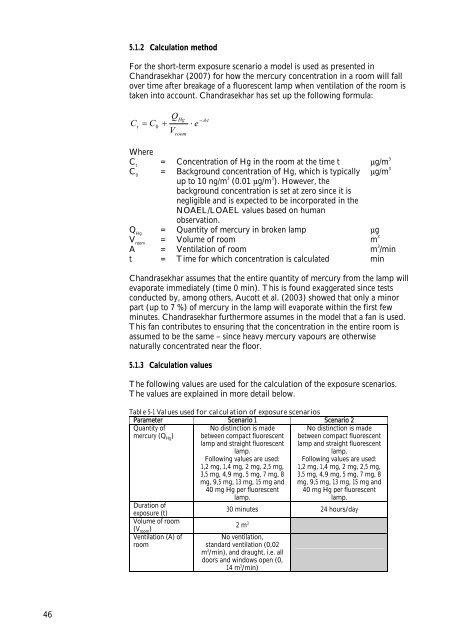No. 104 - Miljøstyrelsen
No. 104 - Miljøstyrelsen
No. 104 - Miljøstyrelsen
Create successful ePaper yourself
Turn your PDF publications into a flip-book with our unique Google optimized e-Paper software.
46<br />
5.1.2 Calculation method<br />
For the short-term exposure scenario a model is used as presented in<br />
Chandrasekhar (2007) for how the mercury concentration in a room will fall<br />
over time after breakage of a fluorescent lamp when ventilation of the room is<br />
taken into account. Chandrasekhar has set up the following formula:<br />
C<br />
t<br />
Q<br />
� C0<br />
�<br />
V<br />
Hg<br />
room<br />
� e<br />
� A�t<br />
Where<br />
Ct = Concentration of Hg in the room at the time t µg/m 3<br />
C0 = Background concentration of Hg, which is typically<br />
up to 10 ng/m 3<br />
(0.01 µg/m 3<br />
). However, the<br />
background concentration is set at zero since it is<br />
negligible and is expected to be incorporated in the<br />
NOAEL/LOAEL values based on human<br />
µg/m 3<br />
observation.<br />
QHg Vroom =<br />
=<br />
Quantity of mercury in broken lamp<br />
Volume of room<br />
µg<br />
m 3<br />
A = Ventilation of room m 3<br />
/min<br />
t = Time for which concentration is calculated min<br />
Chandrasekhar assumes that the entire quantity of mercury from the lamp will<br />
evaporate immediately (time 0 min). This is found exaggerated since tests<br />
conducted by, among others, Aucott et al. (2003) showed that only a minor<br />
part (up to 7 %) of mercury in the lamp will evaporate within the first few<br />
minutes. Chandrasekhar furthermore assumes in the model that a fan is used.<br />
This fan contributes to ensuring that the concentration in the entire room is<br />
assumed to be the same – since heavy mercury vapours are otherwise<br />
naturally concentrated near the floor.<br />
5.1.3 Calculation values<br />
The following values are used for the calculation of the exposure scenarios.<br />
The values are explained in more detail below.<br />
Table 5-1 Values used for calculation of exposure scenarios<br />
Parameter Scenario 1 Scenario 2<br />
Quantity of<br />
<strong>No</strong> distinction is made <strong>No</strong> distinction is made<br />
mercury (QHg) between compact fluorescent between compact fluorescent<br />
lamp and straight fluorescent lamp and straight fluorescent<br />
lamp.<br />
lamp.<br />
Following values are used: Following values are used:<br />
1,2 mg, 1,4 mg, 2 mg, 2,5 mg, 1,2 mg, 1,4 mg, 2 mg, 2,5 mg,<br />
3,5 mg, 4,9 mg, 5 mg, 7 mg, 8 3,5 mg, 4,9 mg, 5 mg, 7 mg, 8<br />
mg, 9,5 mg, 13 mg, 15 mg and mg, 9,5 mg, 13 mg, 15 mg and<br />
40 mg Hg per fluorescent 40 mg Hg per fluorescent<br />
lamp.<br />
lamp.<br />
Duration of<br />
exposure (t)<br />
30 minutes 24 hours/day<br />
Volume of room<br />
2 m3 (V room)<br />
Ventilation (A) of<br />
room<br />
<strong>No</strong> ventilation,<br />
standard ventilation (0,02<br />
m 3 /min), and draught, i.e. all<br />
doors and windows open (0,<br />
14 m 3 /min)

















